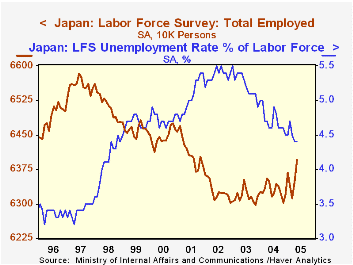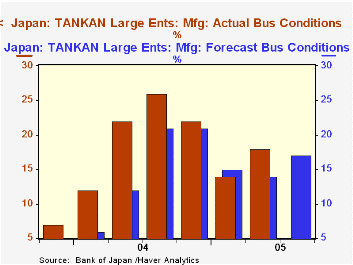 Global| Jul 01 2005
Global| Jul 01 2005Japanese Employment, Unemployment and TANKAN All Show Improvement
Summary
The Japanese labor market looks to be turning around. We last wrote about these employment data three months ago, and in that discussion, Louise Curley called them "disappointing" for February. Another weak performance followed in [...]

The Japanese labor market looks to be turning around. We last wrote about these employment data three months ago, and in that discussion, Louise Curley called them "disappointing" for February. Another weak performance followed in March. But April and May have seen strong gains in jobs, totaling 830,000, and the unemployment rate, at 4.4% in both months, is the lowest since late 1998. The number unemployed has been below 3.0 million in four of the last six months, also the lowest since that late 1998 period.
Further, overall labor force participation - employment plus unemployment as a percentage of the working age population - has started to rise. From a recent peak of just under 64% in early 1997, this ratio moved down steadily to a low of barely 60% just last November. It has since added 0.8 percentage point, an indication of rising consumer confidence.
Employment is seeing gains in both manufacturing and non-manufacturing sectors. Factory jobs are still lower than than a year ago, but they rose 300,000 in May, a large monthly gain. Nonmanufacturing employment touched 50.0 million for the first time in May, an increase of 270,000 on the month. [These figures cover nonagricultural employment only.]
These employment results bear out what business leaders told the Bank of Japan in the quarterly TANKAN survey. Its "headline series", the diffusion index for large manufacturing companies, reached +18 in Q2, up 4 points from Q1 and also 4 points higher than the forecast these company managers had made three months ago. This is particularly encouraging after that Q1 result fell short of both the preceding quarter and its own forecast. The special linked TANKAN index Haver reports in the G10 database, which covers all enterprises in all industries, is hovering right around 0, also its best performance since late 1997.
| Japan | May 2005 | Apr 2005 | Mar 2005 | May 2004 | 2004 | 2003 | 2002 |
|---|---|---|---|---|---|---|---|
| Employment (millions) | 63.95 | 63.53 | 63.12 | 63.48 | 63.30 | 63.16 | 63.29 |
| Change (thousands) | 420 | 410 | -270 | 0.7% | 0.2% | -0.2% | -1.3% |
| Unemployment (millions) | 2.96 | 2.93 | 2.97 | 3.08 | 3.13 | 3.50 | 3.59 |
| Unemployment Rate (%) | 4.4 | 4.4 | 4.5 | 4.6 | 4.7 | 5.2 | 5.4 |
| Participation Rate* (%) | 60.8 | 60.5 | 60.1 | 60.5 | 60.4 | 60.8 | 61.2 |
Carol Stone, CBE
AuthorMore in Author Profile »Carol Stone, CBE came to Haver Analytics in 2003 following more than 35 years as a financial market economist at major Wall Street financial institutions, most especially Merrill Lynch and Nomura Securities. She had broad experience in analysis and forecasting of flow-of-funds accounts, the federal budget and Federal Reserve operations. At Nomura Securities, among other duties, she developed various indicator forecasting tools and edited a daily global publication produced in London and New York for readers in Tokyo. At Haver Analytics, Carol was a member of the Research Department, aiding database managers with research and documentation efforts, as well as posting commentary on select economic reports. In addition, she conducted Ways-of-the-World, a blog on economic issues for an Episcopal-Church-affiliated website, The Geranium Farm. During her career, Carol served as an officer of the Money Marketeers and the Downtown Economists Club. She had a PhD from NYU's Stern School of Business. She lived in Brooklyn, New York, and had a weekend home on Long Island.





